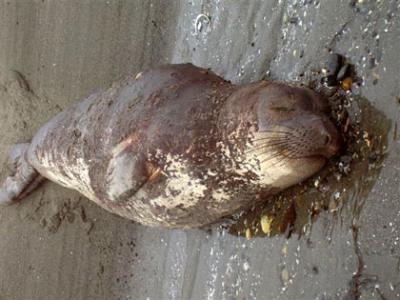
The Seal Saga Continues

“Our neighbor is spraying a baby seal with a garden hose. That’s not right, is it?” This inquiry came from a concerned caller on Bainbridge Island, who got our phone number from off-Island stranding responders. Evidently, they heard the word "island," but not which island. No worries: I explained Seal Pup 101 to the nice lady, gave her Kitsap County contact numbers, and told her the neighbor must stop watering the baby seal as if s/he were a hydrangea.
To add to the commotion of Vashon-Maury pupping season, in early August Odin and I responded to several reports about a large brown seal that looked sick and listless. That critter proved to be a juvenile Northern Elephant Seal (NES), five feet long, in the early stages of molting. The last time we had a molting NES on Vashon, the seal roamed from beach to beach around the Island. Dear readers, please call the VHP immediately if you spot the NES. We want to monitor the molt and avert disruptive activity near this seal.
Molting Elephant Seals are as vulnerable as newborn seal pups. The molt is uncomfortable but natural, and it lasts 4–5 weeks. Some seals develop skin lesions -- a condition called scabby molt. A molting NES will rest on shore for prolonged periods. Do not attempt to feed or pour water on the seal; keep dogs away; and do not approach the seal within 100 yards. As with all pinnipeds, harassing an Elephant Seal violates the Marine Mammal Protection Act. This week’s photo shows a young, molting NES snoozing at KVI beach.
At Chez VHP, we have seen a mother and baby Harbor Seal pair swimming together, often with Junior clinging to Mom. The other day, we heard the baby crying for Mama – a pitiful, plaintive cry. The tide was high; mom and baby were both in the water. I watched through binoculars as Junior searched for 20 minutes and then found Mom, enthusiastically reuniting with her. Poor Junior is in for a rude awakening when Mom weans him in a few weeks.
We are grateful to Celia, who said she had been on Vashon just two days when she found an hours-old seal pup on a remote west side beach. We could not beat the incoming tide to check on the newborn, so her cell phone photos were tremendously helpful. May this inspire other Islanders to email photos of seals and whales to the VHP. Your photos contain valuable clues that aid our work with marine mammals.
As stranding responders, Odin and I strive to educate and maintain harmony between seals and humans. A simple phone call can save a baby seal’s life. We aim to eliminate pup abandonment due to human interference on Vashon, and to avoid unnecessary rehab placements for our baby seals.
In my last article, I provided a link to NOAA’s "Sharing the Shore with Harbor Seal Pups" fact sheet, only to find that NOAA revised the web page. Here is the correct link: www.nmfs.noaa.gov/pr/pdfs/health/northwest/sharetheshore_harborsealpups.pdf
Please support the work of the Vashon Hydrophone Project (VHP): REPORT LOCAL WHALE SIGHTINGS ASAP TO 463-9041, as well as seal pups and sick, injured, or dead marine mammals on Island beaches. Prompt reports to the VHP expedite vital data collection efforts by Mark Sears and other researchers, and sustain an accurate record of whale sightings for Vashon-Maury initiated three decades ago. Check for updates at Vashonorcas.org and send photos to Orca Annie at Vashonorcas@aol.com. Oh, and don’t hose down the baby seals, OK?
- Login to post comments
